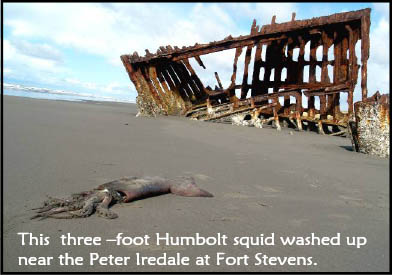

|
1 |
2 |
3 |
4 |
|
PAGES |
|||

Beachcombing: Always an Adventure Winter is an especially great time for beachcombing. Winter storms cause water to be churned up from the ocean floor and then pushed ashore. General Manager Keith Chandler calls this phenomenon an "ocean burp" because it looks like the ocean has belched a huge amount of debris on the shore. Sometimes the ocean burp deposits huge clumps of kelp, other times the debris is more evenly scattered. Aquarium staff beachcomb regularly after storms looking for treasures for the Aquarium. Jason cuts up the tops of kelp to freeze to feed to the sea urchins throughout the year. He, Keith, and Tiffany find a variety of odds and ends on the beach to use for displays. Among their finds: a huge collection of goose neck barnacles on a log, moon snail shells, whole baby sand dollars, hermit crabs, mussel bunches, and skate egg cases.
Beachcombing treasures vary widely. It is very rare to find a glass float, but it is possible. It is more likely to see
a variety of unusual sea life washed up. Recently a number of Humboldt squid washed ashore. Up to seven feet
long, these deep water animals are rarely seen onshore. Sometimes salmon sharks wash up on the beach. The day
following a storm is a great time to look for skate egg cases. The skate egg cases look like kelp pouches and can
house a number of skate embryos. If the egg case remains wet, the embryos can survive. If you find something
unusual while beachcombing, take it to the aquarium and they might be able to help you identify it. What’s Happening Here?
|
|||||||
|
1 |
2 |
3 |
4 |
|
PAGES |
|||
| ||||
| ||||